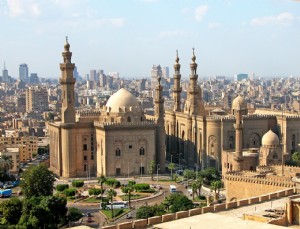The new capital of Egypt

The metropolis of Cairo with 20 million inhabitants is one of the world's fastest growing areas with an annual growth of about half a million people. The number of residents is expected grow to 40 million people by 2050. But because of the high population density and lack in urban planning, the development of the infrastructure of the city is lagging behind the insatiable growth.
For example, Cairo has only three metro lines and the traffic congestion is notorious. Furthermore the city is annually also visited by nearly 15 million tourists. In the wake of a 2010 World Bank study - which found the economic losses due to traffic congestion in Cairo is about 4% of Egypt's GDP - and after a period of political instability affecting the progress of infrastructure projects, the country's government decided to build a whole new capital from scratch. This larger city will be an economic driver in the short and long term by relieving pressure on Cairo, attracting new investments and create jobs.
Located 45 kilometers east of original Cairo, the hitherto unnamed city is under construction since 2015. The showpiece of President El-Sisi is expected to be completed in 2022 and the first permanent residents are expected by the end of this year.
When completed, the city will accommodate 6 million people in an area of 700 km². To put this in perspective: it is the size of Singapore or twice the size of present-day Cairo. Most government agencies will relocate, including the cabinet, parliament, ministries and foreign embassies are encouraged to follow. With regard to the urban structure, plans include large green spaces, a brand new parliament building, a business district with the largest skyscraper in Africa, a new central bank, an airport bigger than Heathrow in London, a theme park bigger than Disneyland and finally a presidential palace eight times the size of the White House.
A solar park of 90 square kilometers will supply part of the electricity demand, while a large central park - twice the length of New York - will be the 'green backbone' of the city. The entire project will require an investment of $45 billion dollars. Although most of the cost is borne by the Ministry of Defense - the previous owner of the land on which the city is being built - and the Ministry of Housing, these contributions are not enough in order to cover the costs. The rest of the funding is to come from the United Arab Emirates and China. However, it is rumored that some of these foreign investors have withdrawn from the project due to disagreements with the government of El-Sisi.
Still, the first phase of the three-part project is already at an advanced stage and therefore the government administration may move soon. It is still unclear what will happen with the two remaining phases, but Egypt is no stranger to mega projects. From the big pyramids in Giza, formed in 2500 BC, to the Suez Canal built in the 19th century and the Aswan High Dam built in the 1960s, eventually all of these projects were realized.
Click here to read/print the article as a pdf file.

